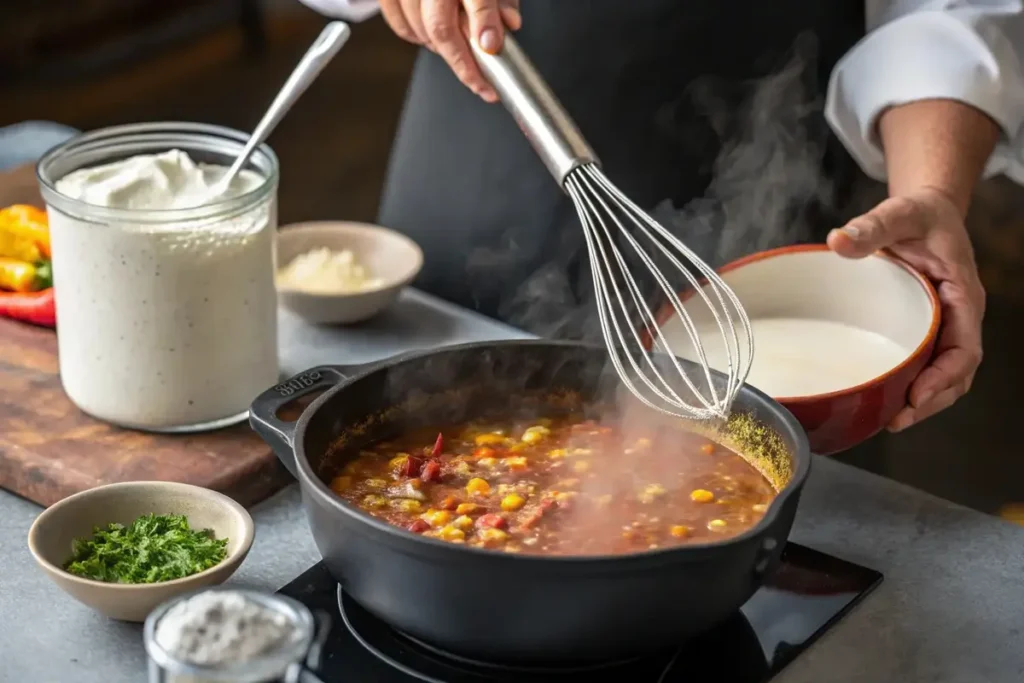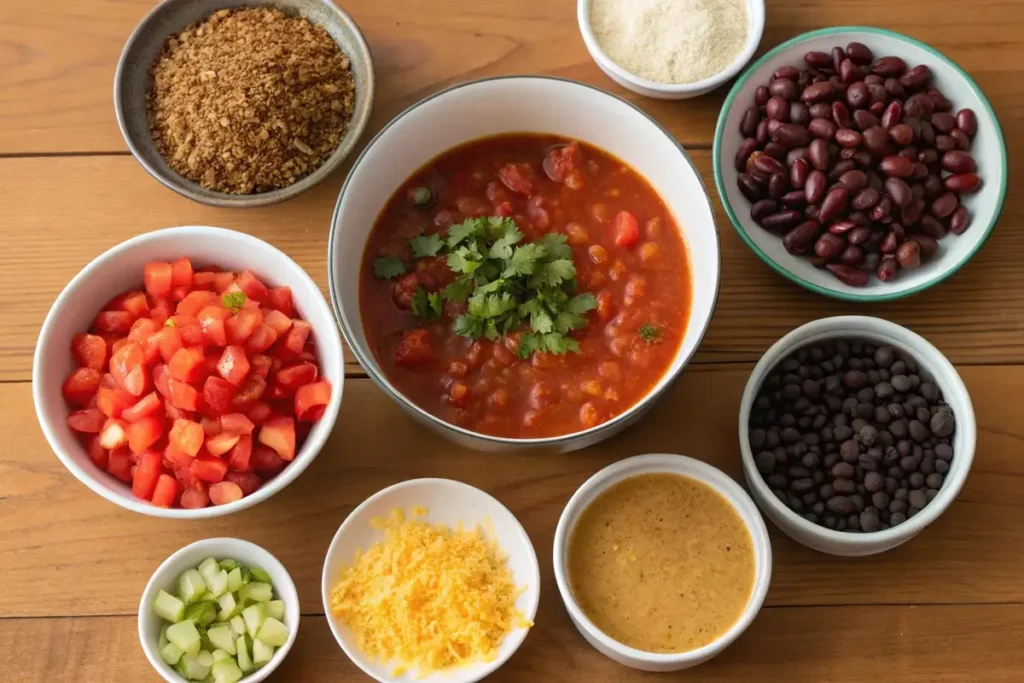Introduction
There’s nothing more disappointing than preparing a comforting pot of taco soup only to find it’s too watery. A runny soup can dilute the rich Tex-Mex flavors you were aiming for, leaving it less satisfying. But don’t worry! This article dives into the possible reasons why your taco soup is so watery and offers practical fixes to thicken it up. From understanding the causes of thin soup to learning tried-and-true thickening methods, we’ll guide you every step of the way to achieve the perfect, hearty consistency.
Understanding the Causes of Watery Taco Soup
Causes of Watery Taco Soup
Excess Liquid in the Recipe
One of the most common reasons taco soup becomes watery is simply adding too much liquid. It’s easy to overdo it when pouring in broth, stock, or even canned tomatoes with their juice. This excess liquid can overwhelm the other ingredients, leaving the soup unbalanced.
High-Moisture Ingredients
Certain vegetables, like fresh tomatoes or zucchini, can release a lot of water as they cook. While they contribute to the flavor, their moisture content can thin the soup unexpectedly. Additionally, using frozen vegetables without draining them thoroughly can add unnecessary liquid.
Insufficient Cooking Time or Temperature
If your soup hasn’t simmered long enough, the liquid may not have had enough time to reduce. Similarly, cooking at a temperature that’s too low can prevent evaporation, resulting in a thinner consistency.
Lack of Proper Thickening Agents
Not incorporating a thickening agent, like cornstarch, flour, or masa harina, can leave the soup too runny. These ingredients are crucial for binding the liquid and creating that hearty texture taco soup is known for.
How Liquid Balance Impacts Flavor and Texture
Effect of Too Much Broth or Stock
Adding too much broth can dilute the spices and seasoning, muting the bold flavors that make taco soup so irresistible. It can also make the texture less satisfying, as the soup feels more like a stew broth than a thick, cohesive dish.
How Thin Soup Can Dilute Taco Soup Spices
When the liquid overpowers the soup, the spices like chili powder, cumin, and paprika don’t stand out as much. This can make the soup taste bland, even if the right amount of seasoning was used. Achieving the perfect balance of liquid ensures every bite is flavorful and rich.
Traditional Methods to Fix Watery Taco Soup
Using Thickening Agents
Adding Cornstarch or Flour Slurry
One of the quickest and most effective ways to fix watery taco soup is by adding a cornstarch or flour slurry.
Step-by-Step Guide to Creating a Slurry
- In a small bowl, combine one tablespoon of cornstarch (or all-purpose flour) with two tablespoons of cold water.
- Stir until the mixture forms a smooth, lump-free liquid.
- Slowly pour the slurry into the simmering soup while stirring continuously.
- Allow the soup to cook for an additional 3–5 minutes to activate the thickening properties. You’ll notice the soup’s texture becoming richer and more cohesive.
Both cornstarch and flour are effective, but cornstarch tends to create a clearer, more glossy finish, while flour offers a slightly creamier texture.

Incorporating Masa Harina for Authenticity
Masa harina, a finely ground corn flour, is a traditional ingredient in Mexican cuisine, often used in tamales and tortillas. It’s also a fantastic thickener for taco soup.
Explaining the Role of Masa Harina in Mexican Dishes
Masa harina not only thickens the soup but also enhances its flavor with a subtle, earthy corn taste. To use it, mix 1–2 tablespoons of masa harina with a small amount of warm water to form a paste. Stir the paste into the simmering soup and let it cook for 5–10 minutes. The result is a beautifully thickened soup with a touch of authenticity.
Cooking Techniques to Reduce Liquid
Simmering Uncovered to Evaporate Excess Liquid
Cooking your taco soup uncovered allows steam to escape, reducing the liquid naturally. Once the soup reaches a gentle simmer, remove the lid and let it cook for 15–20 minutes, stirring occasionally. This technique not only thickens the soup but also intensifies the flavors as the liquid reduces.
Adding Starches Like Potatoes or Rice
Starchy ingredients like diced potatoes or uncooked rice can absorb excess liquid while adding heartiness to your soup.
Benefits of Using Starches for Texture
Potatoes break down slightly as they cook, releasing starch that thickens the soup naturally. Similarly, rice expands and soaks up liquid, creating a thicker, more satisfying consistency. Add these ingredients early in the cooking process to ensure they have enough time to soften and integrate fully.
Creative Alternatives for Thickening Taco Soup
Using Ingredients Already in Your Kitchen
Mashing Beans for a Creamy Consistency
Beans, like black or pinto beans, can double as a thickening agent. Scoop out a portion of the beans from your soup, mash them with a fork or blender, and stir them back into the pot. This method creates a creamy, hearty texture without adding extra ingredients.
Blending Vegetables to Naturally Thicken
Cooked vegetables like carrots, zucchini, or sweet potatoes can be blended into a smooth puree and added to your taco soup. This not only thickens the soup but also boosts its nutritional value.
Enhancing Soup with Dairy Products
Stirring in Cream or Sour Cream
Adding a dollop of cream or sour cream during the final stages of cooking gives the soup a rich, velvety texture. These ingredients also balance the spice with their mild, tangy flavor.
Using Shredded Cheese as a Thickener
Stir shredded cheese, like cheddar or Monterey Jack, directly into the hot soup. As the cheese melts, it thickens the broth while adding a savory depth.
Adding Crushed Tortilla Chips or Crackers
How Tortilla Chips Can Absorb Excess Liquid
Crushed tortilla chips are an easy, flavorful way to thicken taco soup. Add a handful of chips to the pot and let them simmer for a few minutes. They’ll break down and blend into the broth, creating a thicker texture with a hint of corn flavor. Crackers can serve the same purpose but may slightly alter the soup’s taste.
Preventative Measures for the Future
Tips for Avoiding Watery Taco Soup
Measuring Liquid Ingredients Accurately
One of the simplest ways to prevent watery taco soup is to measure your liquid ingredients carefully. Use measuring cups for broth or water rather than estimating. Recipes often include guidelines for liquid amounts, but remember that personal preferences and ingredient variations may require slight adjustments.

Choosing Low-Moisture Ingredients
Some ingredients naturally contain more water than others. For example, fresh tomatoes can release a significant amount of liquid as they cook. Opt for canned, drained diced tomatoes to control moisture levels. Similarly, ensure frozen vegetables are thawed and patted dry before adding them to your soup.
Allowing Enough Simmering Time
Rushing the cooking process often leads to thin, watery soup. Simmering taco soup for an adequate amount of time not only thickens the broth by reducing excess liquid but also enhances the flavor as the ingredients meld together. Keep the lid off during this process to allow steam to escape and the liquid to concentrate.
Adjusting the Recipe to Fit Your Preferences
Reducing Liquid at the Start
If you prefer a thicker soup, start by reducing the amount of broth or water in the recipe. Use less liquid than suggested, and you can always add more later if needed. This approach gives you greater control over the final consistency without requiring additional thickening agents.
Testing Consistency Before Serving
Before serving, give your soup a quick stir and assess its consistency. If it feels too thin, you can easily adjust by adding a thickener or letting it simmer uncovered for a few extra minutes. Testing ensures your taco soup reaches the perfect texture every time, delighting your taste buds and avoiding any watery disappointments.
Frequently Asked Questions (FAQs)
FAQs About Watery Taco Soup
Can I Fix Watery Soup Without Adding More Ingredients?
Yes, you can fix watery taco soup without introducing additional ingredients. The most straightforward method is to simmer the soup uncovered, allowing excess liquid to evaporate naturally. This technique reduces the broth while concentrating the flavors. Another option is to use a handheld blender to puree a portion of the soup, thickening it with its own ingredients. Both methods are effective and maintain the original balance of flavors.
What Are Some Gluten-Free Options to Thicken Taco Soup?
Gluten-free thickeners like cornstarch, arrowroot powder, and tapioca starch work beautifully for taco soup. Mix one tablespoon of the thickener with two tablespoons of cold water to create a slurry, then stir it into the soup. Masa harina is another excellent option, as it is naturally gluten-free and enhances the flavor with a subtle corn taste. Always ensure that any store-bought ingredients are certified gluten-free to avoid cross-contamination.
How Do I Thicken Taco Soup in a Slow Cooker?
Thickening taco soup in a slow cooker is easy if you follow the right steps. First, keep the lid off for the final 30 minutes of cooking to let steam escape and reduce the liquid. You can also add a cornstarch or masa harina slurry at this stage, stirring it into the soup and allowing it to cook on high until the desired consistency is reached. For a natural thickening method, mash some of the beans or add crushed tortilla chips directly into the slow cooker.
Can I Use Refried Beans to Fix Watery Taco Soup?
Absolutely! Refried beans are a quick and flavorful way to thicken taco soup. Stir one or two spoonfuls of refried beans directly into the soup and let it simmer for a few minutes. The beans will dissolve into the broth, adding creaminess and a hearty texture. This method not only thickens the soup but also enhances its flavor, making it richer and more satisfying.
What Dairy-Free Thickeners Work Best?
For those avoiding dairy, options like coconut cream, cashew cream, or blended silken tofu work exceptionally well. These alternatives provide the same creaminess as traditional dairy but cater to lactose-intolerant or vegan preferences. Another effective dairy-free thickener is chia seeds. When soaked and blended, chia seeds create a gel-like consistency that thickens soups naturally. Each of these choices adds richness while maintaining a smooth texture.
Conclusion
Achieving the Perfect Consistency for Taco Soup
Recap of Causes and Solutions
Watery taco soup can happen for various reasons, from excess liquid to insufficient cooking time. Thankfully, the solutions are just as varied and effective. By using thickening agents like cornstarch or masa harina, mashing beans, or blending vegetables, you can transform a thin soup into a hearty, flavorful dish.
Encouragement to Experiment with Thickeners
Don’t be afraid to experiment! Whether you’re using crushed tortilla chips for a Tex-Mex twist or trying coconut cream for a dairy-free option, there’s no one-size-fits-all solution. With these tips and techniques, you’ll be able to achieve the perfect taco soup consistency every time, delighting your family and friends with a meal that’s both comforting and satisfying.

